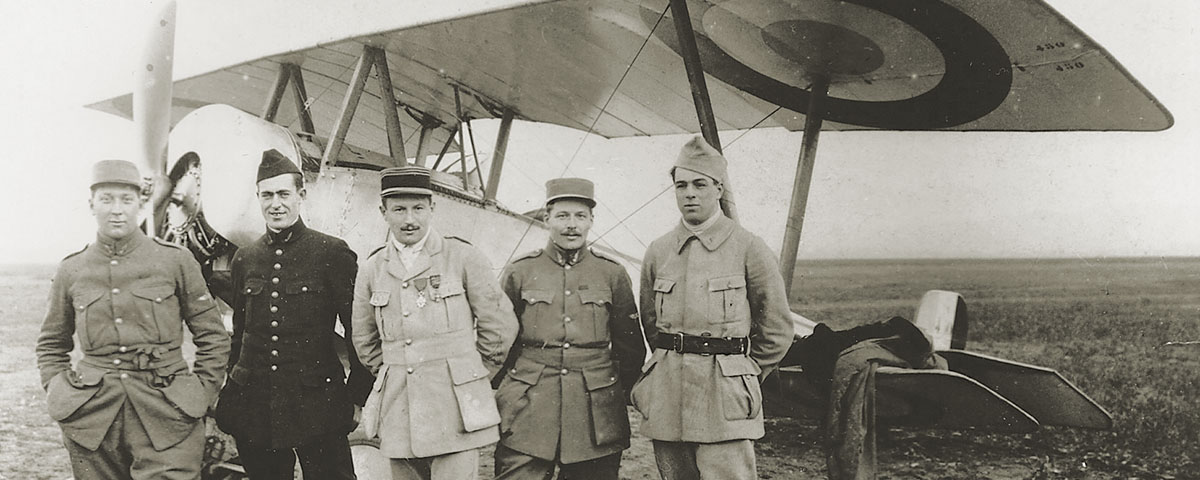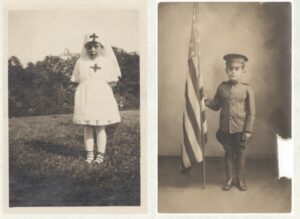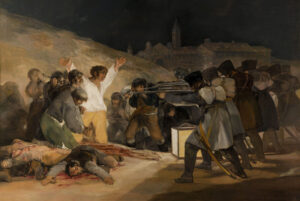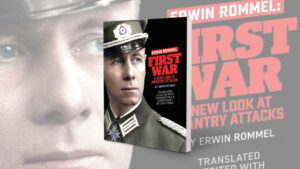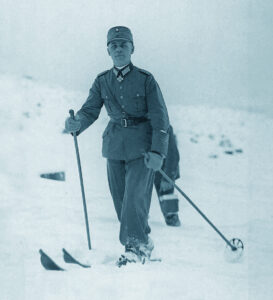In 1914, as World War I erupted across Europe, James “Mac” McConnell knew he could no longer stay on the ground.

BUNDLED HEAD-TO-TOE IN THEIR FUR-LINED FLIGHT SUITS, Edmond Genet, Edwin Parsons, and James “Mac” McConnell, pilots of the famed Lafayette Escadrille in World War I, walked across an airfield in Saint Juste, France, to their Nieuport 17 biplanes. McConnell, suffering from a wrenched back (the result of a horrific crackup), had to have his French mechanics help him into his bucket seat. Soon, the three aluminum-painted aircraft were bobbing in close formation in the cold, misty skies above Ham, 80 miles north of Paris. Although it was just 9 o’clock in the morning of March 19, 1917, this was the squadron’s third patrol of the day. The three pilots had been ordered to protect the larger, more cumbersome observation machines soaring above no man’s land.
Flying low at first, the pilots could easily see the French cavalry overrunning the countryside. In this sector the Germans were in full retreat, pulling back to a heavily fortified position known as the Hindenburg Line. Having systematically destroyed all the abandoned towns and villages, the Germans were leaving behind a barren, burned-out, and abused landscape. “Before we had gone very far Parsons was forced to go back on account of motor trouble,” Genet wrote two days later. But he and Mac kept going. Genet reported that at about 10 o’clock, “Mac suddenly headed into the German lines toward Saint Quentin and I naturally followed close to his rear and above him.”
Well inside hostile territory the American airmen encountered two enemy single-seaters—dark green fish-like Albatros D.IIIs—and accelerated into combat. McConnell and Genet quickly lost track of each other in the swirling melee that ensued. Within moments, one of Genet’s left airfoils was torn apart by a stream of explosive bullets—projectiles banned by the 1899 Hague Convention because they were considered inhumane. “I was momentarily stunned by part of [the airfoil],” he recalled, noting that it “dug a nasty gouge into my left cheek.” A battery of enemy antiaircraft guns now joined the fray, their shells exploding into ominous spider shapes.
Read More: This WWI aviator was known as the ‘Ace of Aces’
Also locked in a circling dance of death, McConnell and the other German each jockeyed for an advantage, sometimes darting within 25 yards of each other. Now the familiar dull staccato of machine-gun fire, the smell of motor fuel and hot gun oil, and the dizzying thrill of high-speed airborne combat filled the American’s senses. Jimmy McConnell—bon vivant, ideologue, thrill-seeker—was exactly where he wanted to be.
JAMES ROGERS McCONNELL WAS BORN IN CHICAGO ON MARCH 14, 1887. Two years later his father, Samuel P. McConnell, a judge on the Circuit Court of Cook County, moved the family to New York City, where he worked as the president of a large building-contracting firm and as a legal representative of the massive interests of the Vanderbilt family. For Judge McConnell the next stop, in 1905, was Carthage, North Carolina, as the president of a railroad company.
Aside from these moves and his family’s affluence, young McConnell’s childhood was shaped by several strong influences. His Chicago home, according to historian Philip Alexander Bruce, was close to that of “one of the earliest pioneers in aviation, who was in the habit of studying the wings and flight of birds, and testing the results of his observations with primitive machines in a vacant lot just under the boy’s window.” (The unnamed “pioneer” was most likely French-American civil engineer and aviation authority Octave Chanute, whose 1894 book, Progress in Flying Machines, carefully analyzed every method of manmade flight thus far attempted.) McConnell also formed an enduring attachment to France from spending many happy years there with his mother and two younger sisters. It was clear, too, that he craved adventure. In June 1902 McConnell and a friend—both of them just 14—got into a four-horsepower automobile in New York City that he’d bought three months earlier to drive all the way to Chicago (some 1,000 miles). The feat attracted lots of attention from the press, and crowds of well-wishers lined their route.
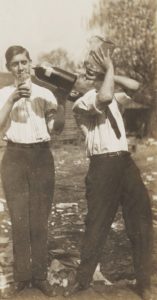
In 1907 McConnell, who had been educated at private schools, registered at the University of Virginia—a stuffy Southern school deeply rooted in the past. Students walking the campus, for example, only acknowledged those to whom they had been formally introduced. While many freshmen there felt snubbed, the broad-shouldered, cheerful youngster from Chicago exuded self-confidence and quickly became popular among his peers. Considered a rather brilliant student, McConnell nonetheless manifested his genius in extracurricular activities. He was an assistant cheerleader and a member of Beta Theta Pi, Theta Nu Epsilon, ribbon-society T.I.L.K.A., the German Club (which organized cotillions), and the extremely secretive Seven Society. He helped found the University Aero Club and was editor in chief of Corks and Curls, a student publication. He entertained throngs of well-lubricated students by playing the bagpipes and was blamed for firmly attaching a chamber pot to the head of a statue of Thomas Jefferson, UVA’s founder, just before it was unveiled for a crowd of dignitaries that included President William Howard Taft. (McConnell was not expelled for the incident, probably because a plumber removed the pot just in time.) McConnell’s most notable UVA distinction, however, was his reign as king of the Hot Foot Society, a student organization whose annual coronation ceremony featured a raucous parade, in which the king and queen led an assortment of wildly dressed medieval-style pages, musicians, cupbearers, jesters, and guards.
McConnell left in 1910 without a degree. Bouncing around, he first worked in New York City, and then returned to North Carolina for a position with his father’s railroad.
JIMMY McCONNELL WAS STILL IN CARTHAGE WHEN, on July 28, 1914, World War I erupted across Europe. By the end of the year, with northern France overrun by the Germans and more than 300,000 French soldiers killed and wounded, McConnell knew he could no longer simply stay on the sidelines, despite the United States’ neutrality.
To McConnell, a great crusade beckoned. France, the nation he so adored, was facing an evil of immense proportions. Many feared that the very future of Western civilization was at stake. “The war to end all wars” promised glory, romance, and escape. It was, as McConnell saw it, the opportunity of a lifetime.
In January 1915 McConnell told a startled friend in Carthage that he was “all fixed up”—he had a job driving an ambulance in France. “These Sand Hills will be here forever,” he said, “but the war won’t; and so I’m going.”
A month later McConnell was a driver with Section 2 of the American Ambulance Field Service headquartered at Pont-à-Mousson on the Moselle River in northeastern France. In Europe he joined the ranks of thousands of young, idealistic American ambulance volunteers serving the cause of humanity in the Great War. (A number of them later went on to great fame, including E. E. Cummings, Ernest Hemingway, and John Dos Passos.) “Tomorrow, I am going to the front with our squad and twelve ambulances,” McConnell wrote a stateside friend in April. “I am having a glorious experience.”
Not content merely to drive an ambulance, McConnell soon began writing articles for publications in the United States, whose readers were hungry for details about the horrors of the European conflict. His piece in the September 1915 issue of Outlook, with an introduction by former U.S. president Theodore Roosevelt, was considered one of the best written about the ambulance service. “The work at night is quite eerie, and on moonless nights quite difficult,” McConnell wrote. “It is only in the dazzling light of the illuminating rockets that shoot into the air and sink slowly over the trenches that one can see to proceed with any speed. It is at night, too, that our hardest work comes, for that is usually the time when attacks and counter-attacks are made and great numbers of men are wounded. Sometimes all twenty of the Section cars will be in service. It is then that one sees the most frightfully wounded: the men with legs and arms shot away, mangled faces, and hideous body wounds. It is a time when men die in the ambulances before they reach the hospitals.”
ON OCTOBER 5, 1915, McCONNELL WAS AWARDED FRANCE’S CROIX de GUERRE WITH STAR, for “courage and fearlessness worthy of the highest praise.” But for McConnell, that wasn’t enough. “All along I had been convinced that the United States ought to aid in the struggle against Germany,” he wrote. “With that conviction, it was plainly up to me to do more than drive an ambulance. The more I saw of the splendour of the fight the French were fighting, the more I felt like an embusque—what the British call a ‘shirker.’ So I made up my mind to go into aviation.”
On October 1, 1915, following the acceptance of his application, a series of examinations, the signing of a flurry of documents, and his swearing of allegiance to the French Foreign Legion (not the nation of France, thus adhering to U.S. neutrality), Jimmy McConnell officially joined the Aéronautique Militaire. He soon found himself at a flying school outside Pau, France, at the base of the Pyrenees, 400 miles south of Paris. There, prospective pilots began by first skittering down the airfield in rouleurs (rollers)—wingless Blériot XIs dubbed “Penguins” because they couldn’t possibly take off—then advancing to low-powered planes capable of limited flight. Once they’d mastered the controls, landing and taking off, and completed 30 hours in the air, students received their brevet militaire, or pilot’s license, after passing an altitude test (maintaining the height of 6,000 feet for one hour) flying two 40-mile petit voyages, and completing three “triangle” air flights. For these jaunts, the novice airmen, using just a compass, map, and landmarks on the ground, had to fly to two distant towns and have their papers signed by local officials before returning to their aerodrome.
Then came classroom instruction, a three-week course in aerial gunnery, an intense and frequently fatal four-week course in acrobatics and air combat, and another class in formation and group flying. McConnell received his brevet militaire on February 6, 1916. With his training well underway, he was excited to finally wear a French uniform. What thrilled him even more, however, was learning that he would soon become a member of a new, all-American escadrille de chasse, or fighter squadron.
Escadrille N. 124 (a.k.a. the Escadrille Americaine) was the brainchild of Norman Prince and William Thaw, scions of extremely well-to-do American families. By late 1915, both were serving as combat pilots in the French air service. When they—along with another American pilot, Elliot Cowdin—were given leave to return to the States, the enthusiastic press coverage of their visit convinced them that France would gain tremendous American support with the formation of an all-American squadron. With the backing of powerful allies in the French government, and among the wealthy Americans living in Paris, Prince and Thaw sold their idea to General Auguste Edouard Hirschauer, the head of French aviation.
Escadrille N. 124 became official on April 16, 1916. Its original roster included McConnell and six other Americans: Cowdin, a Harvard University graduate from Long Island, New York; Prince, another Harvard man, from Massachusetts; Thaw, a Pennsylvanian who’d left Yale University to pursue a career in aviation; Tennessee-born Kiffin Rockwell, who’d attended Washington and Lee University in Virginia; New York City–born Harvard graduate Victor Chapman; and Weston Birch “Bert” Hall, who, though charming, was an inveterate liar (nobody was ever sure of his real birthplace—he named several—or whether the amazing experiences he was so fond of recounting were true). In these other Americans—Hall excepted—McConnell found young men of the same stripe: They were well-heeled, idealistic, and spirited. They were also eager to help France in her dire time of need. In command of this unique collection of volunteers were two prominent French fliers, Captain Georges Thenault and Lieutenant Alfred de Laage de Meux.
The members of the Escadrille Americaine first assembled at Luxeuil-les-Bains, an old spa town near the Swiss border. McConnell wrote enthusiastically of the aerodrome’s wonderful facilities and numerous technicians, but then noted “the ancient custom of giving a man selected for the sacrifice a royal time of it before the appointed day.” At Luxeuil the squadron was issued 80-horsepower Nieuport 11s, which were affectionately known as bébés because of their diminutive size. What they lacked in bulk, however, they more than made up for in speed, maneuverability, and rate of climb.
During the squadron’s first sortie, the pilots soared to 13,000 feet then headed over the trenches—what McConnell called “a series of brown, woodworm-like tracings on the ground.” Suddenly, he continued, “two balls of black smoke…appeared close to one of the machines ahead of me, and with the same disconcerting abruptness similar balls began to dot the sky above, below, and on all sides of us. We were being shot at with shrapnel….The roar of my engine drowned the noise of the explosions. Strangely enough, my feelings were wholly impersonal….”
In May 1916, N. 124 was transferred to the Bar-le-Duc airfield behind the Verdun sector. Here the war was brutally real. Over “the furnace of Verdun”—as the massive killing field would become known—the squadron fought 146 combats and recorded 13 confirmed victories. Many of its flights involved protecting French observation and range-finding aircraft. “Sailing high above these machines we felt like an old hen protecting her chickens,” McConnell wrote. Often flying three missions a day, the Americans also patrolled the front and escorted bombers over enemy territory. “Now the east is pink, and overhead the sky has changed from gray to pale blue,” Mac, as the pilots were now calling him, wrote. (The nickname was stenciled on his fuselage). “The country below has changed into a flat surface of variegated figures. Woods are irregular blocks of dark green, like daubs of ink spilled on a table; fields are geometrical designs of different shades of green and brown, forming in composite an ultra-cubist painting.”
McConnell, who participated in many of these missions, was determined to bag an enemy plane. “Getting started is the hardest part of an attack,” he wrote. “Once you have begun diving you’re all right….Now the black Maltese crosses on the German’s wings stand out clearly. You think of him as some sort of big bug….The rattle of the gun that is aimed at you leaves you undisturbed. Only when the bullets pierce the wings a few feet off do you become uncomfortable. You see the gunner crouched down behind his weapon, but you aim at where the pilot ought to be—there are two men aboard the German craft—and press on the release hard. Your mitrailleuse [machine gun] hammers out a stream of bullets.” Despite his attempts, McConnell never scored an official “kill.”
IN LATE AUGUST, McCONNELL BARELY SURVIVED A NASTY CRACKUP when he misjudged the length of the landing field. Coming down at the end of the airfield, his Nieuport bolted along the ground, toward the woods, at 100 miles an hour. “I saw soldiers running to be in at the finish and I thought to myself that James’s hash was cooked,” he later wrote, “but I went between two trees and ended up head-on against the opposite bank of the road.” The plane was smashed and his back was badly injured. McConnell was determined to remain at the front—he flew in pain for several days—but Thenault ordered him to the rear to recuperate.
Ironically, while he was away from the front, McConnell made his greatest contribution to the Allied war effort by writing action-packed articles for the November 1916 and March 1917 issues of World’s Work magazine. At the Paris residence of a close friend, he quickly expanded these pieces into a 157-page book titled Flying for France that was published by Doubleday, Page & Company of New York.
Here was a taste of combat fresh from the smoked-filled skies over the Western Front. And here, in McConnell’s graphic descriptions, the American people were given ample evidence of the need for their assistance. “Through [McConnell] more than any other single individual, America is beginning to catch the real and very vital significance of this most tremendous of all world struggles,” Edwin Alderman, the president of the University of Virginia, wrote to Judge McConnell. “Through him we are at last waking to the realization that the cause of the Allies is our own.”
Unfortunately for McConnell, the war went on without him. From Bar-de-Luc the Escadrille Americaine returned to Luxeuil, where it remained until mid-October. There the pilots acquired a mascot—a lion cub they named Whiskey—and there they were issued Nieuport 17s, flying machines larger and more powerful than the Nieuport 11s. The 17s were also better armed, boasting a synchronized, belt-fed Vickers machine gun that fired through the propeller as well as an optional Lewis gun above the upper wing. On November 16, yielding to German diplomatic protests (the United States was still a neutral nation), the Escadrille Americaine was renamed the Escadrille des Volontaires. On December 6, because of both wartime international squabbling and the desire to honor the Marquis de Lafayette, World War I’s most famous fighter squadron received the name by which it is known—and revered—to this day, L’Escadrille Lafayette. From Luxeuil the squadron was transferred to Cachy, 60 miles north of Paris, its home until late January 1917. Ravenel was N.124’s next posting, and the squadron remained there until early April.
By late February, McConnell had finagled his way back into the squadron, flying sorties against German observation balloons. His back pain was so bad that he needed help getting dressed. Worse yet, because it restricted his head movement, he no longer had total vision in the cockpit, essential for survival in the air.
Five days later, on March 19, “Mac” flew his last mission. When Genet’s plane was blasted by explosive bullets, the stunned pilot unloaded his machine gun at the enemy, and then headed home. Muffled antiaircraft detonations chased him back toward friendly lines. “I straightened out over Ham at a thousand meters,” Genet later wrote, “and began to circle around looking for Mac or the other Boche, but saw absolutely nothing.”
Four days later a French cavalry patrol discovered the shattered remains of Mac’s Nieuport No. 2055 in a small apple orchard near Petit Détroit, just south of Flavy-le-Martel. McConnell’s horribly mangled corpse—stripped of everything, including his boots—still lay alongside the wreck. The cavalrymen had witnessed Mac’s last combat, reporting that two enemy two-seaters had shot up his Nieuport just before it plummeted to earth, though the Germans credited the kill to Second Lieutenant Heinrich Kämmerer of Jagdstaffel (Fighter Squadron) 20. “The machine was scarcely distinguishable so badly had it smashed into the ground,” wrote a distraught Genet to Paul Rockwell, “and there is scarcely any doubt, Paul, that Mac was killed while fighting in the air, as no pilot would have attempted to land a machine in the tiny rotten field.”
Thus perished James Rogers McConnell, one of the Lafayette Escadrille’s original seven flyers. Of the unit’s initial roster, Victor Chapman—the first American pilot killed in World War I—had been shot down on June 23, 1916; a dogfight with a German two-seater claimed Kiffin Rockwell’s life on September 23 of that year; and Norman Prince had been mortally injured in a landing crackup on October 12. McConnell, the fourth original member of N.124 to die, became the last American pilot killed before the United States officially entered the war on April 6, 1917.
He was buried where he fell. The citizens of a nearby village, Ham, raised enough money to erect a memorial stone at the site. Locals still refer to the little field as l’entroit de l’aviateur, or “place of the flier.” (In 1928 McConnell’s remains were transferred to the Lafayette Escadrille Memorial near Paris.)
The citizens of Carthage, North Carolina, where McConnell was living when World War I broke out, also erected a memorial to him—a tall granite obelisk that was dedicated on April 1, 1917. Later that same year France sent an additional memorial in honor of “Jacques McConnell.”
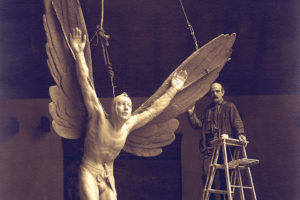
The University of Virginia community was shocked to learn of McConnell’s death. Although it had been seven years since his departure, his many antics there were still the topic of campus banter. In the summer of 1917—thanks to monies pouring in for a memorial—the university commissioned internationally renowned sculptor Gutzon Borglum to produce a statue of McConnell. Rather than portraying his subject in a French uniform, Borglum—best known for completing the massive Mount Rushmore National Memorial in 1941—sculpted instead a winged, nearly naked, warrior poised in flight. Titled “The Aviator,” the 12-foot-tall bronze depicts McConnell as Icarus, the character from Greek mythology who, after crafting wings of bird feathers held together with wax, flew too close to the sun and fell to earth. Borglum’s statue—bearing the inscription “Soaring like an eagle into new heavens of valor and devotion”—was unveiled in 1919.
Back at the Ravenel aerodrome just days after McConnell died, his escadrille mates opened a letter he’d left containing instructions regarding his funeral and where to send his meager belongings. “My burial is of no import,” he wrote. “Make it as easy as possible for yourselves. I have no religion and do not care for any service. If the omission would embarrass you I presume I could stand the performance. Good luck to the rest of you. God damn Germany and vive la France.” MHQ
Rick Britton, a historian and cartographer, lives in Charlottesville, Virginia.
[hr]
This article appears in the Spring 2019 issue (Vol. 31, No. 3) of MHQ—The Quarterly Journal of Military History with the headline: The Aviator

Want to have the lavishly illustrated, premium-quality print edition of MHQ delivered directly to you four times a year? Subscribe now at special savings!

